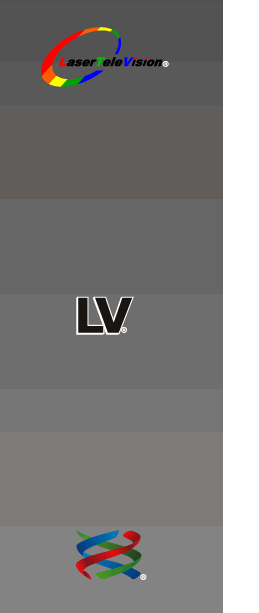|




The major advantages
of a laser display are superior picture quality and longer life. Our
(LLE) Laser Light Engine® produces more natural color, a greater range of
colors, and higher resolution. It offers long-term stability of color
purity and brightness, absence of motion or decoding artifacts, low power
consumption, environmental compliance, lighter weight, wide depth of
field, ability to maintain focus when projected on irregular surfaces, and
wide angle of view.
All color video requires an RGB color
source. Other projection systems start with white light and separate
out the three primary colors (red, green and blue) through the use of
filters. The difficulties in separating a pure color from white light
inherently reduces color accuracy. A laser projector has the advantage of
starting with pure, saturated red, green, and blue light, each of a
specified wavelength.
Unlike chip-based technologies [e.g., liquid
crystal displays (LCDs), plasma display panels, digital light processors
(DLPs), laser projection systems do not require internal processors,
allowing them to image fast-moving subjects without ghosting. Laser images
are not limited by the purity of phosphors contained in CRTs or ion
exchange gases, as plasma devices are. Because each laser emits fully
saturated color, the video images they produce are lifelike in their color
reproduction. LightRush has patented, for projection applications, a broad
range of colors for each laser. By using wavelengths contained within its
patent, the LightRush projector can produce an extremely large color space
(gamut). The CIE chromaticity diagram below shows the gamut of visible
light. Portions outlined indicate color gamuts for various imaging media.




Projector lamps produce
wavelengths that generate heat. They require warm-up before stabilizing.
Over time colors may drift. Variations in lamp filaments compound the
problem.
Brightness and resolution are independent in laser
systems. With other video display technologies, an increase in
brightness washes out the colors and reduces contrast. On CRTs, for
example, increasing the brightness results in decreased resolution,
referred to as 'blooming.' LCD systems suffer color shift and other
performance problems due to the heat generated by their filament light
source.
Increasing the power output of the lasers does not reduce
the system's resolution capability. Conversely, increasing the resolution
of the system does not decrease overall image brightness. Increased
brightness does not dilute laser color.
The LightRush® laser
system is environmentally friendly. It does not contain phosphorous,
lead shielding, or mercury. It doesn't generate harmful electromagnetic
radiation. It is energy efficient, consuming less power than any other
display technology capable of similar size images.
Solid-state
lasers are long-life components making our LLE® a potentially
maintenance-free projector. There are no projector lamps for the user to
replace at a cost ranging from $200 to $1000 or more for every 1,000 to
2,000 hours of use. Even though some manufacturers claim over 2,000 hours
of use, such bulbs typically suffer significant loss of brightness before
failure. LightRush®'s lasers suffer none of these shortcomings.
This
provides a high-contrast, film-like picture, rather than a pixelized
image. When viewed on large screens, images that are represented by
discrete pixels can be very distracting (like looking through a screen
door). CRTs, DLPs, LCDs, and plasma displays all have a fixed pixel layout
whose grid produces spatial frequency beats when they are used in
conjunction with a lenticular screen.
DLPs, LCDs and plasma
displays all require image processing that can result in motion and
decoding artifacts created by the spatial modulation methods evidenced by
annoying effects within an image. LightRush®'s display requires no image
processing that will result in image artifacts.

